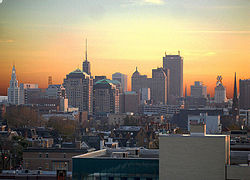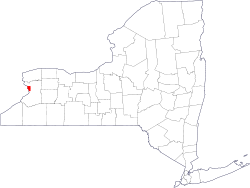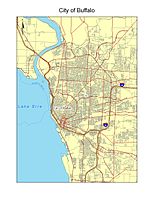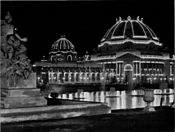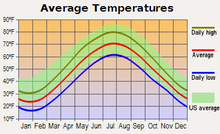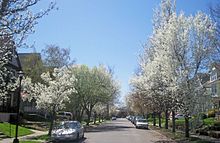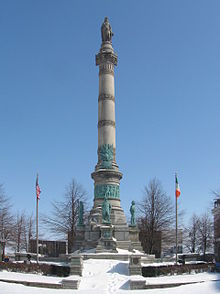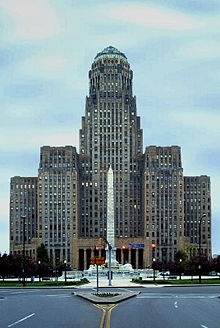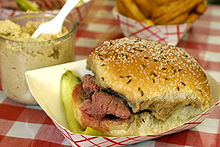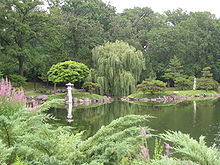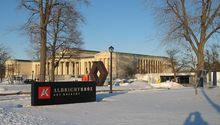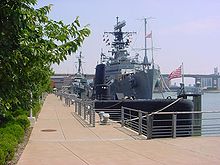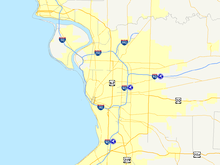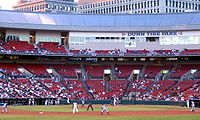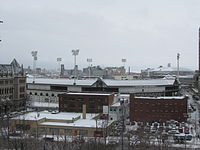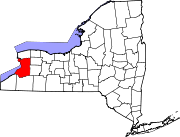- Buffalo, New York
-
City of Buffalo — City — 
Flag
SealNickname(s): The City of Good Neighbors, The Queen City, The City of No Illusions, The Nickel City, Queen City of the Lakes, City of Light Location of Buffalo in New York State City of Buffalo street map Coordinates: 42°54′17″N 78°50′58″W / 42.90472°N 78.84944°WCoordinates: 42°54′17″N 78°50′58″W / 42.90472°N 78.84944°W Country United States State New York County Erie First Settled 1789 Founded 1801 Incorporated (City) 1832 Government – Mayor Byron Brown (D) – Common Council Members' ListArea – City 52.5 sq mi (136.0 km2) – Land 40.6 sq mi (105.2 km2) – Water 11.9 sq mi (30.8 km2) Elevation 600 ft (183 m) Population (July 1, 2010) – City 261,310 (70th in U.S.) – Density 6,656.2/sq mi (2,568.8/km2) – Urban 976,703 (38th in U.S.) – Metro 1,135,509 (47th in U.S.) – CSA 1,203,997 (37th in U.S.) [1][2] Demonym Buffalonian Time zone EST (UTC−5) – Summer (DST) EDT (UTC−4) Area code(s) 716 FIPS code 36-11000 GNIS feature ID 0973345 Website www.city-buffalo.com [3][4] Buffalo (
 /ˈbʌfəloʊ/) is the second most populous city in the state of New York, after New York City.[1] Located in Western New York on the eastern shores of Lake Erie and at the head of the Niagara River across from Fort Erie, Ontario, Buffalo is the seat of Erie County[5] and the principal city of the Buffalo-Niagara Falls metropolitan area, the largest in Upstate New York. Downtown Buffalo is located 17 miles (27 km) south of Niagara Falls. Buffalo itself has a population of 261,310 (2010 Census) and the Buffalo–Niagara–Cattaraugus Combined Statistical Area is home to 1,215,826 residents.
/ˈbʌfəloʊ/) is the second most populous city in the state of New York, after New York City.[1] Located in Western New York on the eastern shores of Lake Erie and at the head of the Niagara River across from Fort Erie, Ontario, Buffalo is the seat of Erie County[5] and the principal city of the Buffalo-Niagara Falls metropolitan area, the largest in Upstate New York. Downtown Buffalo is located 17 miles (27 km) south of Niagara Falls. Buffalo itself has a population of 261,310 (2010 Census) and the Buffalo–Niagara–Cattaraugus Combined Statistical Area is home to 1,215,826 residents.Originating around 1789 as a small trading community near the eponymous Buffalo Creek,[3] Buffalo grew quickly after the opening of the Erie Canal in 1825, with the city as its western terminus. By 1900, Buffalo was the 8th largest city in the United States,[6] and went on to become a major railroad hub,[7] and the largest grain-milling center in the country.[8] The latter part of the 20th Century saw a reversal of fortunes: Great Lakes shipping was rerouted by the opening of the St. Lawrence Seaway, and steel mills and other heavy industry relocated to places such as China.[9] With the start of Amtrak in the 1970s, Buffalo Central Terminal was also abandoned, and trains were rerouted to nearby Depew, New York (Buffalo-Depew) and Exchange Street Station. By 1990 the city had fallen back below its 1900 population levels.[10]
Today, the region's largest economic sectors are health care and education,[11] and these continue to grow despite the lagging national and worldwide economies.[12] This growth has been maintained, in part, by major expansions of the Buffalo Niagara Medical Campus[13] and the University at Buffalo, The State University of New York.[14] The retail sector of Buffalo's economy is strong with additional revenue from Canadian shoppers who wish to take advantage of lower prices there. A recent study showed that Buffalo's August 2011 unemployment rate of 7.3%[15] In 2010, Forbes rated Buffalo the 10th best place to raise a family in America.[16]
Name origin
In 1798, The Holland Land Company hired Theophile Cazenove of Philadelphia as its agent in the newly established hub for the area in nearby Batavia, NY. Cazenove then hired Joseph Ellicott, to survey the area and establish a village next to Buffalo Creek. Ellicott decided to utilize the spoke pattern for his new village, which he called "New Amsterdam", and centered it around Niagara Square. In 1800, residents of the small village decided they did not like the name "New Amsterdam" and decided it would be called "Buffalo". In 1808, the name was officially changed and the Village of Buffalo had 25 residents at the time.
Most popular accounts hold that the name "Buffalo" is a corruption of the French phrase beau fleuve, "beautiful river," a phrase said to have been exclaimed by French explorers upon seeing the Niagara River. This speculation, however, is contradicted by primary sources. French explorers actually referred to Buffalo Creek in print as Rivière aux Chevaux, "Horse River."[17] The earliest name origin theory to appear in print (1825) relates a story about stolen horsemeat being passed off as bison flesh, with the site of the illicit picnic henceforth remembered as "Buffalo," but the author who conveyed this tale expressed his skepticism.[18] What is clear is that there were no bison in the area; that the settlement of Buffalo took its name from Buffalo Creek;[19] and that Buffalo Creek first appeared on a map in 1759–1760.[20] Although the Beau Fleuve theory is the most appealing but least plausible theory among many, it is unlikely that Buffalo's true name origin can be conclusively established.
History
Main article: History of Buffalo, New YorkPrior to the Iroquois occupation of the region, the region was settled by the Neutral Nation. Later, the Senecas of the Iroquois Confederacy conquered the Neutrals. In 1804, Joseph Ellicott, a principal agent of the Holland Land Company, designed a radial street and grid system that branches out from downtown like bicycle spokes,[21] and is one of the few radial street plans in the US.[citation needed] During the War of 1812, on December 30, 1813,[22]'[23] Buffalo was burned by British forces. On November 4, 1825 the Erie Canal was completed with Buffalo strategically positioned at the western end of the system. At the time, the population was about 2,400. The Erie Canal brought a surge in population and commerce which led Buffalo to incorporate as a city in 1832, with a population of about 10,000 people.
The City of Buffalo has long been home to African-Americans. An example is the 1828 village directory which listed 59 "Names of Coloured" heads of families.[24] In 1845, construction was begun on the Macedonia Baptist Church (commonly called the Michigan Street Baptist Church). This African-American church was an important meeting place for the abolitionist movement. On February 12, 1974 the church was added to the National Register of Historic Places. Abolitionist leaders such as William Wells Brown made their home in Buffalo.[25] Buffalo was also a terminus point of the Underground Railroad[26] with many fugitives crossing the Niagara River from Buffalo to Fort Erie, Ontario and freedom.
During the 1840s, Buffalo's port continued to develop. Both passenger and commercial traffic expanded with some 93,000 passengers heading west from the port of Buffalo.[27] Grain and commercial goods shipments led to repeated expansion of the harbor. In 1843, the world's first steam-powered grain elevator was constructed by local merchant Joseph Dart, Jr. and engineer Robert Dunbar. The "Dart Elevator" enabled faster unloading of lake freighters along with the transshipment of grain in bulk from lakers to canal boats and, later on, rail cars.[27]
Abraham Lincoln visited Buffalo on February 16, 1861 on his trip to accept the presidency of the United States. During his visit, he stayed at the American Hotel on Main Street between Eagle Street and Court Street.[28] The Civil War years saw an increase in the population of Buffalo which grew from 81,029 to 94,210 by 1865. In addition to sending many soldiers to the Union effort, Buffalo manufacturers supplied important war material. For example, the Niagara Steam Forge Works manufactured turret parts for the ironclad ship USS Monitor.[28]
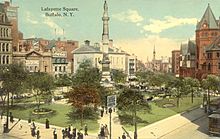 Lafayette Square c. 1912
Lafayette Square c. 1912
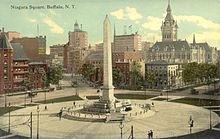 Niagara Square c. 1912
Niagara Square c. 1912
Grover Cleveland served as Sheriff of Erie County (1871–1873), and was Mayor of Buffalo in 1882. He was later Governor of New York (1883–1885), 22nd President of the United States (1885–1889) and 24th President (1893–1897).
In May, 1896, the Ellicott Square Building opened. For the next 16 years, it was the largest office building in the world. It was named after the surveyor Joseph Ellicott.
At the dawn of the 20th Century, local mills were among the first to benefit from hydroelectric power generated via the Niagara River. The city got the nickname City of Light at this time due to the widespread electric lighting.[29] In 1881, Buffalo deployed the first electric street lights in the United States. It was also part of the automobile revolution, hosting the brass era car builders Pierce Arrow and the Seven Little Buffaloes early in the century.[30] City of Light (1999) was the title of Buffalo native Lauren Belfer's historical novel set in 1901, which in turn engendered a listing of real versus fictional persons and places[31] featured in her pages.
President William McKinley was shot and mortally wounded at the Pan-American Exposition in Buffalo on September 6, 1901. He died in the city eight days later and Theodore Roosevelt was sworn in at the Wilcox Mansion as the 26th President of the United States.
An international bridge, known as the Peace Bridge, linking Buffalo to Fort Erie, Ontario was opened in 1927. The Buffalo Central Terminal, a 17-story Art Deco style station designed by architects Fellheimer & Wagner for the New York Central Railroad, was finished just weeks before the Wall Street Crash of 1929.
During World War II, Buffalo saw a period of prosperity and low unemployment due to its position as a manufacturing center.[32][33] The American Car and Foundry company, which manufactured railcars, reopened their Buffalo plant in 1940 to manufacture munitions during the war years.[34]
With the opening of the St. Lawrence Seaway in 1957, which cut the city off from valuable trade routes; deindustrialization; and the nation-wide trend of suburbanization; the city's economy began to deteriorate. Like much of the Rust Belt, Buffalo, which peaked at more than half a million people in the 1950s, has seen its population decline by almost 50 percent as industries shut down and people left for the suburbs or other cities.
Like other rust belt cities such as Flint, Michigan, Buffalo has attempted to revitalize its beleaguered economy and crumbling infrastructure. In the first decade of the 21st century, a massive increase in economic development spending has attempted to reverse its dwindling prosperity. $4 billion was spent in 2007 compared to a $50 million average for the previous ten years.[35] New proposals and renovations are numerous, especially in the downtown core. As of 2008, the population has continued to decrease, despite the efforts of city officials. (See demographics section.)
Geography and climate
Geography
Buffalo is located on the eastern end of Lake Erie, opposite Fort Erie, Ontario in Canada, and at the beginning of the Niagara River, which flows northward over Niagara Falls and into Lake Ontario.
According to the United States Census Bureau, the city has a total area of 52.5 square miles (136 km2). 40.6 square miles (105 km2) of it is land and 11.9 square miles (31 km2) of it is water. The total area is 22.66% water.
Climate
Buffalo has a reputation for snowy winters, but it is rarely the snowiest city in New York State.[36] The region experiences a fairly humid, continental-type climate, but with a definite maritime flavor due to strong modification from the Great Lakes (Köppen climate classification "Dfb" — uniform precipitation distribution). The transitional seasons are very brief in Buffalo and Western New York.
Winters in Western New York are generally cold and snowy, but are changeable and include frequent thaws and rain as well. Winters can also be quite long in Western New York, usually spanning from mid-November to mid-March. Snow covers the ground more often than not from late December into early March, but periods of bare ground are not uncommon. Over half of the annual snowfall comes from the lake effect process and is very localized. Lake effect snow occurs when cold air crosses the relatively warm lake waters and becomes saturated, creating clouds and precipitation downwind. Due to the prevailing winds, areas south of Buffalo receive much more lake effect snow than locations to the north. The lake snow machine starts as early as mid-November, peaks in December, then virtually shuts down after Lake Erie freezes in mid-to-late January. The most well-known snowstorm in Buffalo's history, the Blizzard of '77, was not a lake effect snowstorm in Buffalo in the normal sense of that term (Lake Erie was frozen over at the time), but instead resulted from a combination of high winds and snow previously accumulated both on land and on frozen Lake Erie. Snow does not typically impair the city's operation, but can cause significant damage as with the October 2006 storm.
Buffalo has the sunniest and driest summers of any major city in the Northeast, but still has enough rain to keep vegetation green and lush.[37] Summers are marked by plentiful sunshine and moderate humidity and temperature. It receives, on average, over 65% of possible sunshine in June, July and August. Obscured by the notoriety of Buffalo's winter snow is the fact that Buffalo benefits from other lake effects such as the cooling southwest breezes off Lake Erie in summer that gently temper the warmest days. As a result, the Buffalo station of the National Weather Service has never recorded an official temperature of 100 °F (37.8 °C) or more.[38] Rainfall is moderate but typically occurs at night. The stabilizing effect of Lake Erie continues to inhibit thunderstorms and enhance sunshine in the immediate Buffalo area through most of July. August usually has more showers and is hotter and more humid as the warmer lake loses its temperature-stabilizing influence.
Climate data for Buffalo, New York Month Jan Feb Mar Apr May Jun Jul Aug Sep Oct Nov Dec Year Record high °F (°C) 72
(22)71
(22)81
(27)94
(34)94
(34)98
(37)97
(36)99
(37)98
(37)92
(33)80
(27)74
(23)99
(37)Average high °F (°C) 31
(−1)33
(1)42
(6)54
(12)66
(19)74
(23)80
(27)78
(26)70
(21)59
(15)47
(8)36
(2)55 Average low °F (°C) 18
(−8)19
(−7)26
(−3)36
(2)48
(9)57
(14)62
(17)60
(16)53
(12)43
(6)34
(1)24
(−4)39 Record low °F (°C) −16
(−27)−20
(−29)−7
(−22)5
(−15)25
(−4)36
(2)43
(6)38
(3)32
(0)20
(−7)2
(−17)−10
(−23)−20
(−29)Rainfall inches (mm) 3.16
(80.3)2.42
(61.5)2.99
(75.9)3.04
(77.2)3.35
(85.1)3.82
(97)3.14
(79.8)3.87
(98.3)3.84
(97.5)3.19
(81)3.92
(99.6)3.80
(96.5)40.54
(1,029.7)Snowfall inches (cm) 24.0
(61)18.4
(46.7)12.4
(31.5)3.6
(9.1).3
(0.8)0
(0)0
(0)0
(0)0
(0).3
(0.8)11.0
(27.9)25.4
(64.5)95.4
(242.3)Avg. precipitation days (≥ 0.01 in) 19.8 17.2 15.7 13.6 12.6 11.9 10.5 10.5 11.6 12.8 15.8 19.4 171.4 Avg. snowy days (≥ 0.1 in) 16.7 14.0 9.7 3.7 .2 0 0 0 0 .3 6.0 14.7 65.3 Sunshine hours 89.9 110.2 164.3 204.0 257.3 288.0 306.9 266.6 207.0 158.1 84.0 68.2 2,204.5 Source no. 1: NOAA (normals, 1971−2000) [39] Source no. 2: HKO (sun hours, 1961−1990),[40] Weather.com (extreme temps) [41] Demographics
Historical populations Census Pop. %± 1810 1,508 — 1820 2,095 38.9% 1830 8,668 313.7% 1840 18,213 110.1% 1850 42,261 132.0% 1860 81,129 92.0% 1870 117,714 45.1% 1880 155,134 31.8% 1890 255,664 64.8% 1900 352,387 37.8% 1910 423,715 20.2% 1920 506,775 19.6% 1930 573,076 13.1% 1940 575,901 0.5% 1950 580,132 0.7% 1960 532,759 −8.2% 1970 462,768 −13.1% 1980 357,870 −22.7% 1990 328,123 −8.3% 2000 292,648 −10.8% 2010 261,310 −10.7% Historical Population Figures [42] City proper
Like most formerly industrial cities of the Great Lakes region, Buffalo has experienced an economic depression brought about by the loss of its industrial base. The city's population peaked in 1950, when it was the 15th largest city in the United States and its population has declined in every year since. The demographic change and the impact of such change on the industrial cities of the region, including Buffalo, is significant; based on the 2006 US Census estimate, Buffalo's current population is equivalent to its population in the year 1890, reversing 120 years of demographic change.
Although the trend is inconclusive at this time, current census estimates indicate the rate of population loss may be decelerating to a stable state. The 2008–2009 loss estimate is 50% less than the years prior, and is at less than 1% year-over-year loss. Whether this trend will continue will not be evident until next year's estimate.
At the 2010 Census, the city's population was 50.4% White (45.8% non-Hispanic White alone), 38.6% Black or African American, 0.8% American Indian and Alaska Native, 3.2% Asian, 3.9% from some other race and 3.1% from two or more races. 10.5% of the total population was Hispanic or Latino of any race.[43]
At that time of the 2000 census there were 292,648 people, 122,720 households, and 67,005 families residing in the city. The population density is 7,205.8 people per square mile (2,782.4/km²). There are 145,574 housing units at an average density of 3,584.4 per square mile (1,384.1/km²). The racial makeup of the city is 54.43% White, 37.23% African American, 0.77% Native American, 1.40% Asian, 0.04% Pacific Islander, 3.68% from other races, and 2.45% from two or more races. 7.54% of the population are Hispanic or Latino of any race. The top 5 largest ancestries include German (13.6%), Irish (12.2%), Italian (11.7%), Polish (11.7%), and English (4.0%).[44]
There were 122,720 households out of which 28.6% have children under the age of 18 living with them, 27.6% are married couples living together, 22.3% have a female householder with no husband present, and 45.4% are non-families. 37.7% of all households are made up of individuals and 12.1% have someone living alone who is 65 years of age or older. The average household size is 2.29 and the average family size is 3.07.
In the city the population included 26.3% under the age of 18, 11.3% from 18 to 24, 29.3% from 25 to 44, 19.6% from 45 to 64, and 13.4% who are 65 years of age or older. The median age is 34 years. For every 100 females there are 88.6 males. For every 100 females age 18 and over, there are 83.5 males.
The median income for a household in the city is $24,536, and the median income for a family is $30,614. Males have a median income of $30,938 versus $23,982 for females. The per capita income for the city is $14,991. 26.6% of the population and 23.0% of families are below the poverty line. Out of the total population, 38.4% of those under the age of 18 and 14.0% of those 65 and older are living below the poverty line.
Buffalo has very sizable populations of Irish, Italian, Polish, German, Jewish, Greek, Arab, African American, Indian, and Puerto Rican descent. Major ethnic neighborhoods still exist but they changed significantly in the second half of the 20th century. Traditionally, Polish-Americans were the predominant occupants of the East Side, while Italian-Americans composed a close-knit neighborhood in the west side. The East Side is now a predominantly African American neighborhood, while the West Side has become a melting pot of many ethnicities, with Latino culture being the strongest influence. Throughout the history of Buffalo, the neighborhoods collectively called the First Ward, as well as much of South Buffalo, have comprised almost entirely people of Irish descent. Recently, there has been an influx of inhabitants that are of Arab descent, mainly from Yemen, as the city's Muslim population has increased to approximately 3000 according to an estimate.[45] Since the 1950s and 1960s, the greater portion of the Jewish population has moved to the suburban areas outside of the city, or to the city's upper West Side.
Metropolitan area
Main article: Buffalo-Niagara Falls metropolitan areaAs of 2006, Erie and Niagara Counties had a combined estimated population of 1,154,378.[46] The racial makeup of the area is 82.2% White, 13% African American, 0.6% Native American, 1.32% Asian, 3.3% Hispanic, and 1.4% of all other races. In the metropolitan area, 39.68% of people are under the age of 18 or over the age of 64, and the median age is 38. Of the total population, 82.88% have a high school diploma and 23.2% have obtained a Bachelor's degree. The median income for a household is $48,400 and the per capita income for the area is just under $39,000. Approximately 8% of the population is below the poverty line.
Education
See also: List of Buffalo metropolitan area schoolsPublic schools
Currently, there are 78 public schools in the city including a growing number of charter schools. As of 2006, the total enrollment was 41,089 students with a student-teacher ratio of 13.5 to 1. The graduation rate is up to 52% in 2008, up from 45% in 2007, and 50% in 2006.[47] More than 27% of teachers have a Master's degree or higher and the median amount of experience in the field is 15 years. When considering the entire metropolitan area, there are a total of 292 schools educating 172,854 students.[46] Buffalo has a magnet school system, featuring schools that attract students with special interests, such as science, bilingual studies, and Native American studies. Specialized facilities include the Buffalo Elementary School of Technology; the Dr. Martin Luther King, Jr., Multicultural Institute; the International School; the Dr. Charles R. Drew Science Magnet School; Build Academy; Leonardo da Vinci High School Buffalo; PS 32 Bennett Park Montessori; the Buffalo Academy for the Visual and Performing Arts, BAVPA; the Riverside Institute of Technology; Lafayette High School/Buffalo Academy of Finance; Hutchinson Central Technical High School; Burgard Vocational High School; South Park High School and the Emerson School of Hospitality.
Buffalo is currently in the process of a $1 billion city school rebuilding plan.
Private schools
The city is home to 47 private schools while the metropolitan region has 150 institutions. Most private schools have a Roman Catholic affiliation. There are schools affiliated with other religions such as Islam. There are also nonsectarian options including The Buffalo Seminary (the only private, nonsectarian, all-girls school in Western New York state),[48] and Nichols School.
Complementing its standard function, the Buffalo Public Schools Adult and Continuing Education Division provides education and services to adults throughout the community.[49] In addition, the Career and Technical Education Department offers more than 20 academic programs, and is attended by about 6,000 students each year.[50]
Catholic schools
- Canisius High School
- Bishop Timon - St. Jude High School
- Nardin Academy
- Trinity Catholic Academy
- Ambrose Catholic Academy
- Notre Dame Academy
- Holy Angels Academy
- Mount Mercy Academy
- Our Lady of Black Rock School
Islamic schools
- Darul Uloom Al-Madania
- Universal School of Buffalo [51]
Post secondary education
Colleges and universities
Listed below are institutions that have campuses in the city of Buffalo. Here is a complete list of all the colleges and universities in Western New York.
Private
SUNY
Buffalo is home to three State University of New York (SUNY) institutions. UB and Buffalo State are the largest institutions of their type in the system. The total enrollment of these 3 SUNY institutions combined is approximately 54,000 students in the area.
- University at Buffalo, one of the four University Centers in the SUNY system.
- Buffalo State College, a comprehensive 4 year college affiliated with SUNY.
- Erie Community College a 2 year community college affiliated with SUNY.
Economy
Soldiers' and Sailors' Monument, Lafayette Square
History
Buffalo and the surrounding area were long involved in railroad commerce, steel manufacture, automobile production, aircraft/aerospace design and production, Great Lakes shipping, and grain storage. Most of these industries have left the city through the years. Major steel production no longer exists in the area, although several smaller steel mills remain in operation. For example, Gibraltar Industries, a leading manufacturer, processor, and distributor of steel products for the building, industrial, and vehicular markets is headquartered in Buffalo. As of the 1950 United States Census, Buffalo was the 15th largest city in the country, the nation's largest inland port (twelfth overall), second biggest rail center, sixth largest steel producer, and eighth largest manufacturer.[52]
The regional economy can now best be described as a mix of industrial, light manufacturing, high technology and service-oriented private sector companies. Instead of relying on a single industry or sector for its economic future, the region has taken a diversified approach that have the potential to create opportunities for growth and expansion in the 21st century.[53]
Race
On October 25, 2008 the United Nations released a report entitled "State of the World's Cities" in which the Buffalo-Niagara Falls area was specifically cited as having one of the worst rates of economic inequality in the world and that it was racially based. The report specifically stated "the report cited figures from western New York state, where 40 per cent of black, Hispanic and ethnically-mixed households earned less than $15,000 in 1999, as compared to 15 per cent of white households." [54] In addition, the United States Census department also released information placing the Buffalo-Niagara metro area, as the 8th most segregated area in America.[55]
Employment
Overall, employment in Buffalo has shifted as its population has declined and manufacturing has left. Buffalo's 2005 unemployment rate was 6.6%, contrasted with New York State's 5.0% rate.[56] And from the fourth quarter of 2005 to the fourth quarter of 2006, Erie County had no net job growth, ranking it 271st among the 326 largest counties in the country.[57] Yet the area has recently seen an upswing in job growth as unemployment has dropped to only 4.9% in July 2007 from 5.2% in 2006 and 6.6% in 2005.[58] The area's manufacturing jobs have continued to show the largest losses in jobs with over 17,000 fewer than at the start of 2006. Yet other sectors of the economy have outdistanced manufacturing and are seeing large increases. Educational and health services added over 30,400 jobs in 2006 and over 20,500 jobs have been added in the professional and business (mostly finance) arena.[59]
Life sciences
Buffalo has increasingly become a center for bioinformatics and human genome research, including work by researchers at the University at Buffalo and the Roswell Park Cancer Institute. This consortium is known as the Buffalo Niagara Medical Campus. It also includes: Buffalo Hearing & Speech Center, Buffalo Medical Group Foundation, Hauptman-Woodward Medical Research Institute, Kaleida Health, Olmsted Center for the Visually Impaired, Cleveland BioLabs and Upstate New York Transplant Services. The DNA samples used in The Human Genome Project were also collected from anonymous donors from Buffalo.
Entrepreneurial resources and life science business consultants accelerate the growth and development of emerging companies found within the Buffalo Niagara Medical Campus and Upstate New York Region. For example, Buffalo BioSciences is a technology commercialization partner to the New York State Center of Excellence in Bioinformatics & Life Sciences and contributed to the launch and early success of Empire Genomics –- a firm based on research conducted at Roswell Park Cancer Institute by Dr. Norma Nowak enabling[citation needed] the delivery of personalized medicine.
Banking
Buffalo is the headquarters of M&T Bank, a large regional bank with assets over $79B (as of June 2011).[60] HSBC Bank USA also has major operations in Buffalo. Other banks, such as Bank of America and KeyBank have corporate operations in Buffalo. Citigroup also has regional offices in Amherst, Buffalo's largest suburb. Buffalo has also become a hub of the debt collection industry.[61]
First Niagara Bank recently moved its headquarters to downtown Buffalo from nearby Lockport. First Niagara has branches from Buffalo to Albany, New York, and since September 2009 has had branches as far south as Pittsburgh. On September 10, 2009, First Niagara announced the relocation of its corporate headquarters from Lockport to downtown Buffalo. The company says facilities in Lockport will remain open and fully staffed.[62] First Niagara, which had been considering expanding into Western Pennsylvania for some time,[63] benefited from PNC Financial Services being required by the United States Department of Justice to sell off 50 National City branches in the Pittsburgh area and 11 more branches in and around Erie to competitors,[64] since the two banks had significant overlap in Western Pennsylvania and had potential antitrust issues in that area. First Niagara took advantage by buying 57 of the 61 National City branches from PNC that had to be divested after PNC acquired National City with funds from the $700 billion bailout plan after National City became a victim of the subprime mortgage crisis. The move affected the area by creating 200 more jobs, some in the Buffalo area.[65] On July 31, 2011, it was announced First Niagara had acquired all of HSBC Banks Western New York branches.
Other
Buffalo is home to Rich Products, one of the world's largest family-owned food manufacturers.[66] Canadian brewer Labatt moved its US headquarters to Buffalo in May 2007.[67] This is in large part due to Buffalo's location directly in the middle of the Northeastern Trade Corridor. The city is the heart of the Canadian-American corridor. Over 80% of all U.S.-Canada trade occurs via border crossings in the eastern United States and with five bridges to Canada, the Buffalo area is one of the key eastern border crossing locations. Cheese company Sorrento Lactalis is also based in Buffalo.
New Era Cap Company, the largest sports-licensed headwear company in the United States, is based in Buffalo. It opened new headquarters in 2007 in the former Federal Reserve Building in downtown Buffalo.[68]
The windshield wiper maker Trico operated three major manufacturing facilities but has since closed all of them and moved operations to Mexico. In 1998, the company head office moved to Rochester Hills. Michigan.[69]
For many years, Buffalo was the nation's second largest rail center, after Chicago. Peaked traffic reached during World War II, but declined soon after the war.[70] Through the 1960s and 1970s freight traffic via Buffalo declined, air travel and the New York State Thruway took railway passengers away as well.[71]. By 1980, the rail hub in the city was gone.[72]
Del Monte Foods' Milk Bone dog biscuits are still manufactured in a small factory on the city's East Side.
Regionally based insurance companies also have maintained their headquarters in Buffalo, New York. There’s Merchants Insurance Group and Lawley Insurance. Merchants Insurance Group is a property and casualty insurance company that provides commercial, personal property and casualty insurance throughout the Northeast and North Central United States. Lawley Insurance provides commercial insurance, employee benefits, risk management and personal insurance.
Delaware North Companies are headquartered in Buffalo.[73]
Habasit, the global leader in conveyor belts has a manufacturing facility in Buffalo.[74]
Principal employers
According to the City's 2010 Comprehensive Annual Financial Report,[75] the principal employers in the Buffalo Metropolitan Area as of June 30, 2010 are:
# Employer # of Employees 1 State of New York 16,755 2 University at Buffalo 10,010 3 Kaleida Health 10,000 4 United States of America 10,000 5 HSBC Bank USA 5,848 6 Buffalo Public Schools 5,389 7 Employer Services Corp. 5,380 8 Catholic Health System 5,191 9 County of Erie 4,775 10 M&T Bank 4,640 Largest private sector employers in Western New York
The Buffalo Niagara Enterprise (BNE), "a nonprofit, private business development and regional marketing organization" has released a table containing the largest Private sector employers for Western New York - 2011.[76]
Government
Main article: Politics and Government of Buffalo, New YorkSee also: List of mayors of Buffalo, New YorkAt the municipal level, the City of Buffalo has a council made up of the mayor and nine councilmen. Buffalo also serves as the seat of Erie County with 6 of the 15 county legislators representing at least a portion of Buffalo. At the state level, there are three state assemblymen and two state senators representing parts of the city proper. At the federal level, Buffalo is represented by three members of the House of Representatives.
In a trend common to Northern "Rust Belt" regions, political life in Buffalo has been dominated by the Democratic Party for the last half-century, and has been roiled by racial division and social issues. The last time anyone other than a Democrat held the position of Mayor in Buffalo was 1965 [Chester A. Kowal].[77] In 1977, Democratic Mayor James D. Griffin was first elected as the nominee of two minor parties, the Conservative Party and the Right to Life Party, after he lost the Democratic primary for Mayor to then Deputy State Assembly Speaker Arthur Eve. Griffin switched political allegiance several times during his 14 years as Mayor, generally hewing to socially conservative platforms. His successor, Democrat Anthony M. Masiello (elected in 1993) continued to campaign on social conservatism, often crossing party lines in his endorsements and alliances. In 2005, however, Democrat Byron Brown was elected the city's first African-American mayor in a landslide (64%-27%) over Republican Kevin Helfer, who ran on a conservative platform.
This change in local politics was preceded by a fiscal crisis in 2003 when years of economic decline, a diminishing tax-base, and civic mismanagement left the city deep in debt and teetering on the edge of bankruptcy. At the urging of New York State Comptroller Alan Hevesi, the state took over the management of Buffalo's finances, appointing the Buffalo Fiscal Stability Authority. Conversations about merging the city with the larger Erie County government were initiated the following year by Mayor Tony Masiello, but came to naught.
Cityscape
 Buffalo, New York from I-190 North entering downtown.
Buffalo, New York from I-190 North entering downtown. Downtown view from Niagara Square
Downtown view from Niagara Square
Neighborhoods
Buffalo consists of 32 different neighborhoods: (A map and listing of the neighborhoods from the University at Buffalo) Allentown, Bailey-Lovejoy, Black Rock, Central Park, Clinton-Bailey, Cold Springs, Delaware District, Downtown, East Side, Elmwood Village, Fillmore-Leroy, First Ward, Fruit Belt, Hamlin Park, Hospital Hill, Humboldt Park, Kaisertown, Kensington, Kensington Heights, Lower West Side, Masten Park, North Buffalo, North Park, Parkside, Polonia/Broadway Fillmore, Riverside, Schiller Park, South Buffalo,University District, University Heights, Vernon Triangle, Upper West Side, and Willert Park.
According to the American Planning Association the Elmwood Village neighborhood in Buffalo is ranked the third best neighborhood in America.[78] Elmwood Village[79] is a pedestrian-oriented, mixed use neighborhood with hundreds of small, locally owned boutiques, shops, restaurants, and cafes.
There are currently 9 common council districts in The City of Buffalo. They are: Delaware, Ellicott, Fillmore, Lovejoy, Masten, Niagara, North, South, and University.
Parks
Main article: Buffalo, New York parks systemOne of Buffalo's many monikers is the City of Trees, which describes the abundance of green in the city. In fact, Buffalo has more than 20 parks with multiple ones being accessible from any part of the city.
The Olmsted Park and Parkway System is the hallmark of Buffalo's many green spaces. Three-fourths of city park land is part of the system, which comprises six major parks, eight connecting parkways, nine circles and seven smaller spaces. Begun in 1868 by Frederick Law Olmsted and his partner Calvert Vaux, the system was integrated into the city and marks the first attempt in America to lay out a coordinated system of public parks and parkways. The Olmsted designed portions of the Buffalo park system are listed on the National Register of Historic Places and are maintained by the Buffalo Olmsted Parks Conservancy.
Waterfront
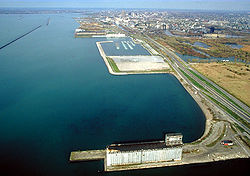 Aerial view of the waterfront at Buffalo, New York. The city is to the north. The highway to the right is New York State Route 5
Aerial view of the waterfront at Buffalo, New York. The city is to the north. The highway to the right is New York State Route 5
Situated at the confluence of Lake Erie and the Buffalo and Niagara Rivers, Buffalo is a waterfront city. The city's rise to economic power came through its waterways in the form of transshipment, manufacturing, and an endless source of energy. Buffalo's waterfront remains, though to a lesser degree, a hub of commerce, trade, and industry.
As of 2009, a significant portion of Buffalo's waterfront is being transformed into a focal point for social and recreational activity. Recently excavated and rewatered is the Erie Canal Commercial Slip, which is the original western terminus of the Erie Canal System. This is intended to revitalize the original Erie Canal Harbor, with shops, eateries,and high-rise condominiums planned. Buffalo's intent is to stress its relatively architectural and historical heritage, creating a tourism destination.
Standard of living
The loss of traditional jobs in manufacturing, rapid suburbanization and high costs of labor have led to economic decline, making Buffalo one of the poorest amongst U.S. cities with populations of more than 250,000 people. An estimated 28.7-29.9% of Buffalo residents live below the poverty line, behind either only Detroit,[80] or only Detroit and Cleveland.[81] Buffalo's median household income of $27,850 is third-lowest among large cities, behind only Miami and Cleveland; however the median household income for the metropolitan area is $57,000.[82]
This, in part, has led to the Buffalo-Niagara Falls metropolitan area having the most affordable housing market in the U.S. today. The quarterly NAHB/Wells Fargo Housing Opportunity Index (HOI) noted that nearly 90% of the new and existing homes sold in the metropolitan area during the second quarter were affordable to families making the area's median income of $57,000. The area median price of homes was $75,000.[citation needed]
Buffalo faces issues with vacant and abandoned houses, as the city ranks second only to St. Louis on the list of American cities with the most vacant properties per capita. Since 2000, the city has torn down 2,000 vacant homes but as many as 10,000 still remain. Mayor Byron W. Brown recently unveiled a $100 million, five-year plan to demolish 5,000 more houses.[83] The city's move away from heavy industry and toward a service and bioinformatics economy[citation needed] has brought improved air and water quality, which benefit not only residents and tourists but the bioregion as a whole. In July 2005, Reader's Digest ranked Buffalo as the third cleanest large city in the nation.[84]
Culture
Nicknames
"The Queen City", Buffalo's most common moniker, first appeared in print in the 1840s, referring to the city's status as the second largest city in New York State after New York City. "The Queen City" was also used during the 19th century to describe Buffalo as the second largest American city on the Great Lakes after Chicago. Buffalo has also been called The Nickel City due to the appearance of a bison on the back of Indian Head nickel in the early part of the 20th century. The City of Good Neighbors refers to the helpful, friendly spirit of its inhabitants.[85] In the early 20th century, the city began calling itself the City of Light both because of the plentiful hydroelectric power made possible by nearby Niagara Falls and because it was the first city in America to have electric street lights.[29]
People
Buffalo was first settled primarily by New Englanders. The first wave of European immigrants was a large influx of Germans. The city was further populated by Irish immigrants first, Erie Canal builders and then escaping famine, and infused by Polish, Italian, Jewish, and more recently Latino populations, all of which have made it a melting pot of ethnic cultures. The newest immigrants are from Somalia, Sudan and Asia.
The Old First Ward retains a strong Irish identity, and Kaisertown reflects a German heritage. Buffalo's Polonia is centered at the Broadway Market on the East Side. The market serves as a microcosm of Polish/Slavic traditions and delicacies.[86] The East Side is now home to African Americans, many of whom came north during the Great Migration. The annual Juneteenth Festival is a large cultural celebration organized by African Americans[87] in Dr. Martin Luther King, Jr. Park.
The West Side is home to the city's Hispanic community, predominantly of Puerto Rican descent. The West Side was once Buffalo's "Little Italy," but in the 1980s much of Buffalo's Italian American community moved to North Buffalo. There is also a small Italian-American enclave in the East Side neighborhood of Lovejoy. Many Buffalo households, churches, and restaurants continue to observe the Sicilian custom of preparing St. Joseph's Day (March 19) tables, at which various meatless Lenten courses are laid out for the poor.
Buffalo is also home to a large Jewish community. German Jewish immigrants originally settled on Buffalo's Westside in the mid-19th century. Lower income Russian Jews and Polish Jews immigrating to the Niagara Frontier in the early 20th century initially settled on the Lower East Side, near William Street and Jefferson Avenue. The community migrated to the Masten Park neighborhood on the East Side, and then to North Buffalo between the 1940s and the 1960s. Although many still live in the city, particularly in North Buffalo and the Delaware District on the city's Westside, the majority of the Buffalo area's Jews now live in the northeastern suburbs. Buffalo's Jewish Community centers are located in the Delaware District, North Buffalo and Amherst.
Distancing itself from its industrial past, Buffalo is redefining itself as a cultural, banking, educational, medical center and architectural tourism destination. In 2001 USA Today named Buffalo the winner of its "City with a Heart" contest.[88] proclaiming it the nation's "friendliest city." Buffalo is also a two-time winner of the All-America City Award.[89]
Food
 Bowl of "Wings"
Bowl of "Wings"
As a melting pot of cultures, cuisine in the Buffalo area reflects a variety of influences. These include Italian, Irish, Jewish, German, Polish, African American, Greek, Indian and American influences. Beef on weck sandwich, Wardynski's kielbasa, Sahlen's hot dogs, sponge candy, pastry hearts, pierogi, and haddock fish fries are among the local favorites, as is a loganberry-flavored beverage that remains relatively obscure outside of the Western New York and Southern Ontario area.[90] Weber's mustard is a well known local producer of horseradish mustard which is popular in the Western NY area. Teressa Bellissimo, the chef/owner of the city's Anchor Bar, first prepared the now-widespread chicken wings here on October 3, 1964.[91] Thousands of Western New Yorkers descend into the city for food festivals during the summer months, such as the Taste of Buffalo and the National Buffalo Wing Festival.[92] There are also festivals themed around ethnic cuisines such as the Italian, Hellenic and Lebanese festivals.
Local or regional chains with a significant presence in the Buffalo area include Louie's Hot Dogs, Ted's Hot Dogs, Anderson's Frozen Custard, John and Mary's Submarines, Duff's Famous Wings, Jim's Steakout, Just Pizza, Spot Coffee, Tim Hortons, Mighty Taco, Leonardi's, Bocce Club and La Nova Pizzeria. Buffalo's pizza is unique. Perhaps because Buffalo is geographically located halfway between New York City and Chicago, Illinois, the pizza made is likewise about halfway between thin-crust New York-style pizza and deep-dish Chicago-style pizza.[93]
The city is home to the Pearl Street Brewery and Flying Bison Brewing Company, who continue Buffalo's brewing traditions. Labatt USA, the US operation for Labatt Beer, a Canadian brewer, is headquartered in Buffalo.[94]
Buffalo has several specialty import/grocery stores in old ethnic neighborhoods, and is home to an eclectic collection of cafes and restaurants that serve adventurous, cosmopolitan fare. Locally-owned restaurants offer Chinese, German, Japanese, Korean, Vietnamese, Thai, Mexican, Italian, Greek, Arab, Indian, Caribbean, Soul food, and French.[95][96]
Several well-known food companies are based in Buffalo. Non-dairy whipped topping, later imitated by Cool Whip, was invented in Buffalo in 1945 by Robert E. Rich, Sr. His company, Rich Products, is one of the city's largest private employers. General Mills was organized in Buffalo, and Gold Medal brand flour, Wheaties, Cheerios and other General Mills brand cereals are manufactured here. One of the country's largest cheese manufacturers, Sorrento, has been here since 1947. Archer Daniels Midland operates its largest flour mill in the city.[citation needed] Buffalo is home to one of the largest privately held food companies in the world, Delaware North Companies, which operates concessions in sports arenas, stadiums, resorts, and many state & federal parks.[97]
Art
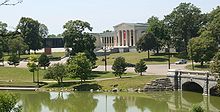 Albright-Knox Art Gallery from Delaware Park (in the back)
Albright-Knox Art Gallery from Delaware Park (in the back)
Buffalo is home to over 50 private and public art galleries,[98] most notably the Albright-Knox Art Gallery, home to a world-class collection of modern and contemporary art. The local art scene is also enhanced by the Burchfield-Penney Art Center, Hallwalls Contemporary Arts Center, CEPA Gallery, and many small galleries and studios.[99][100] AmericanStyle ranked Buffalo fourth in its list of America's top art destinations.
Two street festivals – the Allentown Art Festival and the Elmwood Festival of the Arts – bring thousands of people to the city to browse and purchase original crafts. The Buffalo Philharmonic Orchestra, which performs at Kleinhans Music Hall, is one of the city's most prominent performing arts institutions. In the 1960s and 70s, under the musical leadership of Lukas Foss and Michael Tilson Thomas, the Philharmonic was generally regarded as the leading orchestra in the US for new music. Shea's Performing Arts Center, long known as Shea's Buffalo, is an 1920s movie palace that continues to show productions and concerts. Its interior was designed by Louis Comfort Tiffany. Buffalo is also home to the second largest free outdoor Shakespeare festival in the United States, Shakespeare in Delaware Park. Filmmaker, writer, painter and musician Vincent Gallo was born in Buffalo in 1962 and lived there until 1978 when he moved out on his own to New York City.
Music
Buffalo is also the founding city for several mainstream bands and musicians, most famously Rick James, Billy Sheehan and The Goo Goo Dolls. Vincent Gallo, Buffalo-born filmmaker and musician, played in several local bands. Jazz fusion band Spyro Gyra also got its start in Buffalo.[citation needed] Well-known indie artist Ani DiFranco hails from Buffalo, and it is the home of her "Righteous Babe" record label. 10,000 Maniacs are from nearby Jamestown, but got their start in Buffalo, which led to lead singer Natalie Merchant launching a successful solo career. Death Metal band Cannibal Corpse reached national fame in 1994 when they appeared in the movie Ace Ventura: Pet Detective, at the request of lead actor Jim Carrey.[citation needed] The director agreed and decided to actually have Jim jump on stage with the band and start singing a song of theirs in the film to escape two pursuing goons.[citation needed] Other bands include Every Time I Die, Snapcase, Malevolent Creation and moe. also started off in Buffalo. Power Pop/Indie Punk Trio, Lemuria also derive from Buffalo.
Theatre
Buffalo has a vibrant theatre community, with over 20 professional companies. Major theatres groups include The Kavinoky Theatre, The Irish Classical Theatre, The Theatre of Youth, The Alt at the Warehouse, The Subversive Theatre, Torn Space, Brazen Faced Varlets, Lancaster Opera House, The New Phoenix Theatre and Torn Space Theatre. These companies present a variety of theatre styles and many present original productions by Buffalo playwrights. Each year, the weekly publication ArtVoice sponsors The Artie Awards, celebrating the year in theatre by recognizing top shows and performances. Scores of performers have honed their skills in the Buffalo Theatre Community and have gone on to successful careers in the industry.
Architecture
See also: Category:Buildings and structures in Buffalo, New York and List of tallest buildings in BuffaloThe New York Times has declared that Buffalo is one of the top cities in America for architecture. Approximately 80 sites are included on the National Register of Historic Places. All of the major American architects of the 19th and early 20th century built masterpieces in Buffalo, most of which are still standing. They include:
The country's largest intact parks system designed by Frederick Law Olmsted and Calvert Vaux, including Delaware Park. Buffalo was the first city for which Olmsted designed (in 1869) an interconnected park and parkway system rather than stand-alone parks.
The Guaranty Building, by Louis Sullivan, was one of the first steel-supported, curtain-walled buildings in the world, and its 13 stories made it, at the time it was built (1895), the tallest building in Buffalo and one of the world's first true skyscrapers.[101] It is a National Historic Landmark.
The Hotel Buffalo (originally the Statler Hotel) by August Esenwein and James A. Johnson was the first hotel in the world to feature a private bath in each room.
The H. H. Richardson Complex, originally the New York State Asylum for the Insane, is Richardsonian Romanesque in style and was the largest commission designed by prominent architect Henry Hobson Richardson. The grounds of this hospital were designed by Olmsted. Though currently in a state of disrepair, New York State has allocated funds to restore this treasure.
There are several buildings by Frank Lloyd Wright, including the Darwin D. Martin House, George Barton House, William R. Heath House, Walter V. Davidson House, The Graycliff Estate, as well as the now demolished Larkin Administration Building.[102][103] Constructed in 2007 on Buffalo's Black Rock Canal is a Wright-designed boathouse originally intended, but never built, for the University of Wisconsin–Madison rowing team. Along as a tourist destination, it functionally serves many Buffalo-area rowing teams belonging to the West Side Rowing Club. Buffalo has more Frank Lloyd Wright buildings than any other city except Chicago.
The Buffalo City Hall building by George Dietel and John J. Wade is a spectacular art deco skyscraper and is listed on the National Register of Historic Places.
Other notable buildings:
Albright-Knox Art Gallery from Elmwood Avenue
- Buffalo Central Terminal, the massive Art Deco railroad station designed by Alfred T. Fellheimer and Steward Wagner.
- Lafayette High School, a stone, brick and terra-cotta structure in the French Renaissance Revival style by architects August Eisenwein and James A. Johnson, is the oldest public school in Buffalo that remains in its original building, and is on the National Register of Historic Places.
- St. Adalbert's Basilica, St. Stanislaus, Bishop and Martyr Church, and Corpus Christi are all large, romanesque style, historic churches that can be found on the city's east side.
- Albright-Knox Art Gallery, a world-renowned repository of art, was designed by Edward Brodhead Green. The new modern art wing was designed by Gordon Bunshaft, a native Buffalonian and graduate of the above-noted Lafayette High School.
- Richard Upjohn designed St. Paul's Episcopal Cathedral
- Eliel Saarinen and Eero Saarinen designed Kleinhans Music Hall
- Max Abramovitz designed Temple Beth Zion[104]
- Alexander Phimister Proctor designed the Lions for the McKinley Monument
- Grain elevators were invented here in 1842. Buffalo's collection is the largest in the world.
-
Buffalo City Hall building's art deco
-
Kleinhans Music Hall by Eliel and Eero Saarinen
Nightlife
Last call is at 4 a.m. in Buffalo, rather than 2 a.m. as in most other areas of the U.S. This is often attributed to the historically high density of industrial facilities and the demand of second and third shift patrons. It is also because New York law allows bars to be open until 4 a.m. (However, local municipalities can override it to an earlier time.)
Several distinct and thriving nightlife districts have grown around clusters of bars and nightclubs in the city. The most visible nightlife district is West Chippewa Street,[105] located between Main Street and South Elmwood Avenue. The area is home to high-energy dance clubs, crowded bars, trendy coffeehouses, and restaurants. Allentown, where bars are as numerous but the atmosphere is a bit more relaxed, is a several minute walk north to Allen Street. Allen Street near Main Street houses several bars, while Allen near Elmwood has many bars that feature live music. Continuing up Elmwood Avenue from Allentown is the Elmwood Strip, which runs about two miles (3 km) to Buffalo State College. This strip has numerous small boutiques and restaurants, with few large corporate establishments. Crowds on this strip include everyone from college students to families to the elderly.
Public festivals
Like many large cities, numerous festivals have become part of the city's culture and tradition. Though most of the festivals occur during the summer months, the city has recently pushed efforts to have winter festivals as well in an effort to capitalize on the region's snowy reputation.
Maritime Center boat launch along the Commercial Slip.
Summer festivals
- Allentown Art Festival - Largest festival of the year on the second weekend of June in the city's Allentown neighborhood.
- Taste of Buffalo - One of the largest outdoor food festivals in the country.
- Buffalo Greek Festival
- Italian Festival
- National Buffalo Wing Festival
- Buffalo Brewfest
- Curtain Up! - Marks the beginning of the Buffalo theater season.
- Thursday at the Square - Weekly outdoor summer concert series on Thursday evenings during the summer and fall
- The BASH- A military themed fundraiser in which all proceeds go towards vital disaster preparedness education and response in Western New York communities.
- Elmwood Avenue Festival of the Arts [106]
- Junteenth Festival[107] is an annual celebration of the freedom of slaves.
Winter festivals
- Buffalo Powder Keg Festival
- Labatt Blue Pond Hockey
- Saint Patrick's Day Parade
- Dyngus Day Buffalo
Other points of interest
- Edward M. Cotter fireboat – Considered to be the world's oldest active fireboat and is a United States National Historic Landmark
- Buffalo and Erie County Botanical Gardens
- Buffalo and Erie County Historical Society[108]
- Buffalo Museum of Science[109]
- Buffalo Zoo – The third oldest zoo in the United States established in 1875
- Forest Lawn Cemetery
- "Mark Twain Room" at the Central Branch of the Buffalo and Erie County Public Library.[110] Contains the original manuscript of Huckleberry Finn
- USS Little Rock (CG-4) in Buffalo and Erie County Naval & Military Park
- The Anchor Bar – birthplace of the Buffalo wing or the chicken wing as it is commonly called in the region
- Lafayette Square
- Penn Dixie Paleontological and Outdoor Education Center
Transportation
Airport
Buffalo is served by the Buffalo Niagara International Airport, located in Cheektowaga. The airport, recently re-constructed, serves over 5 million passengers a year and is still growing. Buffalo Niagara International Airport ranks among the five cheapest airports from which to fly in the country, according to the U.S. Bureau of Transportation Statistics. The average round trip flight cost is $295.58.[111] In the last few years there has been a surge in Canadians flying out of Buffalo, mainly due to much cheaper tax and airline surcharges, as compared with Canadian airports and the ability to fly on some US based discount carriers not available in Canada (for example, JetBlue Airways and Southwest Airlines). As of 2006, plans are in the works by U.S. Senator Charles Schumer to make the under-used Niagara Falls International Airport into an international cargo hub for New York and Toronto, as well as Canada as a whole.[112]
The Metro Rail in downtown
Public transit
The Niagara Frontier Transportation Authority (NFTA) operates Buffalo Niagara International Airport and Niagara Falls International Airport, and the public transit system throughout the Buffalo area. The NFTA operates bus lines throughout the city and suburbs, as well as the Metro Rail transit system in the city.
The Metro Rail is a 6.4 miles (10.3 km) long, single line light rail system that extends from Erie Canal Harbor in downtown Buffalo to the University Heights district (specifically, the South Campus of University of Buffalo) in the northern part of the city. The downtown section of the line runs above ground and is free of charge to passengers. North of Theater Station, at the northern end of downtown, the line moves underground, remaining underground until it reaches the northern terminus of the line at University Heights. Passengers pay a fare to ride this section of the rail.
A new NFTA project is underway, often called "Cars on Main Street", that will substantially revise the downtown portion of the Metro Rail. It will allow vehicular traffic and Metro Rail cars to share Main St. in a manner similar to that of the trolleys of San Francisco. The design includes new stations and pedestrian-friendly improvements. The first phase of the project, restoring two way traffic on Main Street between Edward and West Tupper, was completed in 2009. When the entire project is complete in the next few years, the downtown portion of Main St. will be re-opened to vehicular traffic for the first time in almost 30 years.[citation needed]
Intercity rail
Two train stations, Buffalo-Depew and Buffalo-Exchange Street serve the city and are operated by Amtrak.
Freight service for Buffalo is served by CSX Transportation and Norfolk Southern (NS), as well as Canadian National (CN) and Canadian Pacific (CP) railroads from across the Border. The area has 4 large rail yards: Frontier (CSX), Bison (NS), SK (NS / CP) and Buffalo Creek (NS / CSX). A large amount of hazardous cargo also crosses through the Buffalo area, such as liquid propane and anhydrous ammonia.
Waterways
Buffalo is at the eastern end of Lake Erie, one of the Great Lakes, which boasts the greatest variety of freshwater sportfish in the country. The Lake serves as a playground for numerous personal yachts, sailboats, power boats and watercraft, and provides a short water route to excellent sand beaches on the nearby Ontario (Canada) shore. The city has an extensive breakwall system protecting its inner and outer Lake Erie harbors, which are maintained at commercial navigation depths for Great Lakes freighters.
A Lake Erie tributary that flows through south Buffalo is the Buffalo River, for which the city is named. Buffalo is historically linked to the fabled Erie Canal, which ends where the Black Rock Channel enters Lake Erie. When the Canal was dedicated in 1825, its conceiver, New York State governor DeWitt Clinton took waters from Lake Erie at Buffalo's Western Terminus of the Canal (now the Commercial Slip). He sailed to New York City on the Canal packet Seneca Chief, which later returned to Buffalo with Atlantic Ocean water. The seawater was poured into the Lake by Judge and future Buffalo Mayor Samuel Wilkeson. Once a major route for passengers and cargo, the Canal is now used primarily for pleasure craft and some light local freight, and in Buffalo it bypasses the swift upper reach of the Niagara River. A tributary of the Niagara River is Scajaquada Creek, which flows though Buffalo, via the Frederick Law Olmsted-designed Delaware Lake and Park.
National and state highway access

 Interstate 90 (New York State Thruway)
Interstate 90 (New York State Thruway)
 Interstate 190, New York State Thruway's Niagara Section, travels from I-90 in southwest Cheektowaga to Niagara River in Lewiston. The only tolled portion is now the bridges connecting Grand Island to Niagara Falls (north), and Buffalo (south).
Interstate 190, New York State Thruway's Niagara Section, travels from I-90 in southwest Cheektowaga to Niagara River in Lewiston. The only tolled portion is now the bridges connecting Grand Island to Niagara Falls (north), and Buffalo (south). Interstate 290 (New York), Youngmann Memorial Highway, connects Buffalo with its northern suburbs of Amherst and Tonawanda, and provides a route to Niagara Falls that bypasses the city of Buffalo.
Interstate 290 (New York), Youngmann Memorial Highway, connects Buffalo with its northern suburbs of Amherst and Tonawanda, and provides a route to Niagara Falls that bypasses the city of Buffalo. Interstate 990, short interstate highway located entirely in the town of Amherst, NY.
Interstate 990, short interstate highway located entirely in the town of Amherst, NY. U.S. Route 62, Bailey Ave and South Park Ave.
U.S. Route 62, Bailey Ave and South Park Ave. NY Route 5, Main St.
NY Route 5, Main St. NY Route 130, Broadway
NY Route 130, Broadway NY Route 384, Delaware Ave.
NY Route 384, Delaware Ave. NY Route 354, Clinton St.
NY Route 354, Clinton St. NY Route 266, Niagara St.
NY Route 266, Niagara St. NY Route 265, Military Rd. and Tonawanda St.
NY Route 265, Military Rd. and Tonawanda St. NY Route 198, Scajaquada Expressway
NY Route 198, Scajaquada Expressway NY Route 33, Kensington Expwy.
NY Route 33, Kensington Expwy.
Federal offices
US Army Corps of Engineers
The offices of the Buffalo District, US Army Corps of Engineers are located adjacent to the Black Rock Lock in the Black Rock channel of the Erie Canal. In addition to maintaining and operating the lock, the District is responsible for planning, design, construction and maintenance of water resources projects in an area extending from Toledo, Ohio to Massena, New York. These include the flood-control dam at Mount Morris, New York, oversight of the lower Great Lakes (Erie and Ontario), review and permitting of wetlands construction, and remedial action for hazardous waste sites.
Buffalo is also the home of a major office of the National Weather Service (NOAA), which serves all of western and much of central New York State.
Federal Bureau of Investigation (FBI)
Buffalo is home to one of the 56 national FBI field offices. The field office covers all of Western New York and parts of the Southern Tier and Central New York. The field office operates several task forces in conjunction with local agencies to help combat issues such as gang violence, terrorism threats and health care fraud.[113]
Federal courts
Buffalo is also the location of the chief judge, United States Attorney, and administrative offices for the United States District Court for the Western District of New York.
Sports teams
Current teams
Inside Coca-Cola Field, home to the Buffalo BisonsOutside Coca-Cola Field with HSBC Arena in the backgroundSport League Club Founded Venue League championships Championship years Football NFL Buffalo Bills 1960 Ralph Wilson Stadium 2* 1964,1965* Hockey NHL Buffalo Sabres 1970 First Niagara Center 0 Baseball IL Buffalo Bisons 1979 Coca-Cola Field 3 1997, 1998, 2004 Lacrosse NLL Buffalo Bandits 1992 First Niagara Center 4 1992, 1993, 1996, 2008 Soccer NPSL FC Buffalo 2009 All-High Stadium 0 N/A Soccer USL W-League Buffalo Flash[114] 2009 Demske Sports Complex 1 2010 * Championships listed are American Football League championships, not NFL championships.
Former teams
- The Buffalo Bisons of the National League from 1879–1885.
- The Buffalo Bisons of the defunct Players' League in 1890.
- The Buffalo Buffeds/Blues of the defunct Federal League of baseball from 1914–1915.
- The Buffalo Niagaras, Prospects, All-Americans, Bisons, and Rangers of the National Football League from 1918–1929.
- The Buffalo Bisons of the defunct All-America Football Conference in 1946.
- The Buffalo Bills of the defunct All-America Football Conference from 1947–1949.
- The Buffalo Bisons of the American Hockey League from 1940–1970.
- The Buffalo Bisons of the National Basketball League in 1946 which are the Atlanta Hawks.
- The Buffalo Braves of the National Basketball Association from 1970–1978. (became the San Diego Clippers then the Los Angeles Clippers).
- The Buffalo Norsemen of the North American Hockey League from 1975–1976.
- The Buffalo Blazers outdoor soccer team.
- The Buffalo Royals of the World TeamTennis league in 1974.
- The Buffalo Sharks of the American Basketball Association from 2005 to 2008.
- The Buffalo Stallions of the defunct Major Indoor Soccer League from 1979–1984.
- The Buffalo Stampede of the defunct Roller Hockey International from 1994–1995.
- The Buffalo Wings of the defunct Roller Hockey International and Major League Roller Hockey from 1997–1999.
- The Buffalo Blizzard of the defunct National Professional Soccer League II from 1992–2001.
- The Buffalo Destroyers of the Arena Football League from 1999–2003.
- The Queen City FC of the National Premier Soccer League from 2007 to 2008.
Media
Main article: Media in Buffalo, New YorkInternational relations
Twin towns — Sister cities
Buffalo has a number of sister cities as designated by Sister Cities International (SCI):[115][116]
 Lille, France (1989)[117]
Lille, France (1989)[117] Wolverhampton, England, United Kingdom
Wolverhampton, England, United Kingdom Dortmund, Germany (1972)[118]
Dortmund, Germany (1972)[118] Pescasseroli, Italy
Pescasseroli, Italy Siena, Italy (1961)[119]
Siena, Italy (1961)[119] Torremaggiore, Italy
Torremaggiore, Italy Saint Ann, Jamaica (2007)[120]
Saint Ann, Jamaica (2007)[120] Kanazawa, Japan (1962)
Kanazawa, Japan (1962) Rzeszów, Poland (1974)[121][122]
Rzeszów, Poland (1974)[121][122] Tver, Russia (1989)[123]
Tver, Russia (1989)[123] Yeongcheon, North Gyeongsang Province, South Korea (2011)[124]
Yeongcheon, North Gyeongsang Province, South Korea (2011)[124]
Partnerships
Buffalo also has partnerships with the following towns:[125]
 Cape Coast, Ghana
Cape Coast, Ghana Derry, Northern Ireland, UK
Derry, Northern Ireland, UK Drohobych, Ukraine (2001)[126]
Drohobych, Ukraine (2001)[126] Horlivka, Ukraine (2007)[127]
Horlivka, Ukraine (2007)[127] Juba, South Sudan
Juba, South Sudan Kiryat Gat, Israel
Kiryat Gat, Israel Marília, Brazil
Marília, Brazil
While there is no formal relationship, Buffalo and Toronto have enjoy a close link and friendly rivalry between the two cities.
Consulates in Buffalo
- Canada – Consulate-General
Honorary Consulates:
- Austria
- Czech Republic
- France
- Germany
- Italy (Vice Consulate)
- Japan
- Switzerland
See also
- Buffalo Airfield
- Buffalo City Hall
- Buffalo Fire Department
- East Side, Buffalo
- Notable people from Buffalo
- Polish Cathedral
- South Buffalo
- Buffalo buffalo Buffalo buffalo buffalo buffalo Buffalo buffalo
References
- ^ a b US Census Bureau Annual Pop Estimates. census.gov , accessed 3-MAR-2009
- ^ Metropolitan & Central City Population: 2000–2005. Demographia.com. Retrieved September 3, 2006.
- ^ a b First White Settlement and Black Joe - Buffalo, NY. The Buffalonian. Retrieved April 15, 2008.
- ^ The Village of Buffalo 1801 to 1832. The Buffalonian. Retrieved April 15, 2008.
- ^ Erie County Government: Overview. Erie County (New York) Government Home Page. Retrieved April 16, 2008.
- ^ Table 1. Rank by Population of the 100 Largest Urban Places, Listed Alphabetically by State: 1790–1990. U.S. Census Bureau. Retrieved April 16, 2008.[dead link]
- ^ Early Railways in Buffalo. The Buffalonian. Retrieved April 16, 2008.
- ^ "Buffalo as a Flour Milling Center" by Laura O'Day. Economic Geography, Vol. 8, No. 1 (Jan., 1932), pp. 81–93. Published by: Clark University.
- ^ Buffalo History. Buffalo History. Retrieved March 31, 2010.
- ^ U.S. Census Bureau. Retrieved March 31, 2010.
- ^ Buffalo: Economy. City-Data.com. Retrieved March 31, 2010.
- ^ Economic Summary: Western New York Region. New York State Senate. Retrieved March 31, 2010.
- ^ Buffalo Niagara Medical Campus. Urban Design Project. Retrieved March 31, 2010.
- ^ What is UB 2020?. University at Buffalo. Retrieved March 31, 2010.
- ^ Buffalo-Niagara Falls, New York Unemployment from http://www.deptofnumbers.com/. www.deptofnumbers.com. Retrieved March 31, 2010.
- ^ Levy, Francesca (June 7, 2010). "America's Best Places to Raise a Family". Forbes.com. http://www.forbes.com/2010/06/04/best-places-family-lifestyle-real-estate-cities-kids.html.
- ^ Houghton, Frederick. The Name Buffalo. Buffalo, NY: Buffalo Historical Society Publications, v. 24, pp. 63–69 Books.google.com
- ^ Ball, Sheldon. Buffalo in 1825. Buffalo, NY: S. Ball, 1825
- ^ Encyclopedia Britannica: Buffalo, NY, USA
- ^ Houghton, p. 63
- ^ Priebe Jr., J. Henry. "Beginnings —The Village of Buffalo - 1801 to 1832". http://history.buffalonet.org/1801.html. Retrieved 2007-09-07.
- ^ The Buffalonian
- ^ History of Buffalo
- ^ Fordham, Monroe (April 1996). "Michigan Street Church". African American history of Western New York. http://www.math.buffalo.edu/~sww/0history/hwny-michigan.st.church.html. Retrieved 2007-09-08.
- ^ "African American history of Western New York". http://www.math.buffalo.edu/~sww/0history/wwb0.html. Retrieved 2007-09-08.
- ^ "Underground Railroad Sites in Buffalo, NY". http://www.buffaloresearch.com/ugrr.html. Retrieved 2010-07-25.
- ^ a b Priebe Jr., J. Henry. "The City of Buffalo 1840–1850". http://history.buffalonet.org/1840-50.html. Retrieved 2007-09-09.
- ^ a b LaChiusa, Chuck. "The History of Buffalo: A Chronology Buffalo, New York 1841–1865". http://freenet.buffalo.edu/bah/h/1865.html#1859. Retrieved 2007-09-08.[dead link]
- ^ a b Can Buffalo Ever Come Back? from City Journal
- ^ Believe it, or not. Clymer, Floyd. Treasury of Early American Automobiles, 1877–1925 (New York: Bonanza Books, 1950), p.178.
- ^ The History of Buffalo
- ^ "1941–1945". History. Parkside Community Association. http://www.parksidebuffalo.org/history.html.
- ^ Rizzo, Michael. "Joseph J. Kelly 1942–1945". Through The Mayor's Eyes. The Buffalonian. http://www.buffalonian.com/history/industry/mayors/Kelly.htm.
- ^ "Buffalo Car Company". 9 April 2006. http://www.midcontinent.org/rollingstock/builders/buffalo_carco.htm.
- ^ "current city development projects 2007" (PDF). http://www.ci.buffalo.ny.us/files/1_2_1/splanning/listofprojects/ListBuffDev101007.pdf. Retrieved 2007-11-04.
- ^ New York State Golden Snowball Awards.
- ^ Buffalo's Climate. National Weather Service. Retrieved July 5, 2006.
- ^ Weather.com. Record high of 99 °F (37 °C) was recorded in August 1948
- ^ "Climatography of the United States No. 20: BUFFALO NIAGARA INTL AP, NY 1971−2000". National Oceanic and Atmospheric Administration. http://cdo.ncdc.noaa.gov/climatenormals/clim20/ny/301012.pdf. Retrieved 2010-05-14.
- ^ "Climatological Normals of Buffalo". Hong Kong Observatory. http://www.hko.gov.hk/wxinfo/climat/world/eng/n_america/us/buffalo_e.htm. Retrieved 2010-05-14.
- ^ "Monthly Averages for Buffalo, NY". The Weather Channel. http://www.weather.com/outlook/health/fitness/wxclimatology/monthly/graph/USNY0181. Retrieved 2010-12-19.
- ^ "Census". United States Census. http://www2.census.gov/prod2/decennial/documents/1850a-02.pdf. page 36
- ^ "Buffalo Demographics: 2010". quickfacts.census.go. http://quickfacts.census.gov/qfd/states/36/3611000.html. Retrieved November 8, 2011.
- ^ Buffalo, New York (NY) Detailed Profile - relocation, real estate, travel, jobs, hospitals, schools, crime, news, sex offenders
- ^ http://wings.buffalo.edu/sa/muslim/LocalMosques.htm[dead link]
- ^ a b "SUNY Buffalo Regional Knowledge Network". http://rkn.buffalo.edu/data/topicdata.cfm?Topic=100&Region=777.
- ^ The Buffalo News
- ^ Buffalo Seminary - Buffalo Seminary
- ^ "Buffalo Public Schools Adult and Continuing Education Division". http://www.upskill.org/.
- ^ "Career and Technical Education department". http://www.buffaloschools.org/cte/.[dead link]
- ^ Universal School This is no mention in the website of any connection to the Universal School in Illinois. Retrieved 2011 1 November]
- ^ Bisco, Jim (1986). A Greater Look At Greater Buffalo. Windsor Publications. p. 58. ISBN 978-0-89781-198-9.
- ^ University at Buffalo Regional Institute (2011). "Binational Buffalo Niagara Region Report". Regional Knowledge Network. UB Regional Institute. http://rkn.buffalo.edu/reports/region_quick_results.cfm?type=4. Retrieved 2 February 2011.
- ^ UN: Major inequality in US cities - Americas - Al Jazeera English
- ^ CensusScope - Segregation: Dissimilarity Indices
- ^ See Erie County
- ^ BLS, Table 1. Covered establishments, employment, and wages in the 326 largest counties, fourth quarter 2006
- ^ New York
- ^ bizjournals.com
- ^ https://www.mtb.com/aboutus/Pages/WhoIsMT.aspx
- ^ Thompson, Carolyn (2010-01-05). "Buffalo's debt collectors accused of bullying =". Associated Press. http://finance.yahoo.com/news/Buffalos-debt-collectors-apf-2226423347.html?x=0. Retrieved 2010-01-05.
- ^ First Niagara © 2009
- ^ KDKA-TV[dead link]
- ^ United States Department of Justice
- ^ First Niagara © 2009
- ^ Rich Products Corporation :: Our Business/
- ^ LABATT USA: Company opens new headquarters in Buffalo » Business » Tonawanda News/
- ^ History Timeline of the New Era Cap Company/
- ^ http://www.nytimes.com/1999/10/20/nyregion/metro-business-trico-opens-buffalo-site.html
- ^ http://www.buffalohistoryworks.com/terminal/death/death.html
- ^ http://www.buffalohistoryworks.com/terminal/death/death.html
- ^ http://www.buffalohistoryworks.com/terminal/death/death.html
- ^ [1]/
- ^ Habasit Belting (Habasit America, Inc) - Buffalo, New York (NY) | Company Profile/
- ^ "City of Buffalo 2010 Comprehensive Annual Financial Report" (PDF). http://www.ci.buffalo.ny.us/files/1_2_1/Comptroller/CAFR/CAFR_2010.pdf. Retrieved February 13, 2011.
- ^ The list can be found on the BNE website here. This information is obtained from the Business First 2011 Book of Lists.
- ^ Chester A. Kowal
- ^ "American Planning Association". Accessed October 4, 2007 Archived October 11, 2007 at the Wayback Machine
- ^ Forever Elmwood - The Elmwood Village Association
- ^ http://www.usccb.org/cchd/povertyusa/povfact6.shtml
- ^ Buffalo 3rd Poorest Large City. WGRZ TV. Retrieved October 14, 2008.
- ^ Buffalo falls to second-poorest big city in U.S., with a poverty rate of nearly 30 percent. Buffalo News. Retrieved September 2, 2007. Archived October 11, 2007 at the Wayback Machine
- ^ Vacant Houses, Scourge of a Beaten-down Buffalo. New York Times. Retrieved September 14, 2007.
- ^ Derek Burnett,America's Top Five Cleanest Cities. Reader's Digest. Retrieved January 4, 2007. Archived September 26, 2007 at the Wayback Machine
- ^ "Buffalo Widely Knows as 'City of Good Neighbors'". Washington Afro-American: p. 20. August 14, 1951. http://news.google.com/newspapers?nid=2238&dat=19510814&id=CjsmAAAAIBAJ&sjid=rv4FAAAAIBAJ&pg=4955,329648. Retrieved April 4, 2010.
- ^ "The History of the Broadway Market". The Broadway Market. 2009. http://broadwaymarket.org/?page_id=2. Retrieved April 4, 2010.
- ^ Juneteenth Festival of Buffalo, NY. Retrieved 7 July 2007.
- ^ Grossman, Cathy Lynn (2001-02-12). "Lots and lots of heart in Buffalo". USA Today. http://www.cse.buffalo.edu/~rapaport/Buffalo/buffalo.ustoday.html. Retrieved 2007-03-23.
- ^ "All-America City: Past Winners". National Civic League. Archived from the original on 2007-03-22. http://web.archive.org/web/20070322180206/http://www.ncl.org/aac/past_winners/past_winners.html. Retrieved 2007-03-23.
- ^ Horwitz, Jeremy (January 2008). "Loganberry: The Buffalo Drink You'll Like or Love". Buffalo Chow.com. http://www.buffalochow.com/2008/01/loganberry_the_buffalo_drink_y.html. Retrieved 3 July 2009.
- ^ The New Yorker,
- ^ Taste of Buffalo. Retrieved 7 July 2007.
- ^ Addotta, Kip. "Pizza!". Kip Addotta dot com. http://www.kipaddotta.com/food/pizza.html. Retrieved 3 July 2009.
- ^ Buffalo News[dead link]
- ^ "Famous Buffalo and Western New York Foods, Restaurants & Food Festivals". Buffalo Chow.com. http://www.buffalochow.com/buffalofoods.html. Retrieved 3 July 2009.
- ^ "Top 100 Buffalo/WNY Foods (and Restaurants), Part 1 of 5". Buffalo Chow.com. February 10, 2009. http://www.buffalochow.com/2009/02/top_100_buffalowny_foods_and_r.html. Retrieved 3 July 2009.
- ^ "Who We Are — A Global Leader in Hospitality and Food Service". Delaware North Companies Homepage. http://www.delawarenorth.com/Who-We-Are.aspx. Retrieved 3 July 2009.
- ^ City of Buffalo Public Art Collection
- ^ Hallwalls Contemporary Arts Center. Retrieved 7 July 2007.
- ^ CEPA Gallery. Retrieved 7 July 2007.
- ^ Louis Sullivan - Guaranty / Prudential Building, accessed 7 July 2007 Archived July 2, 2007 at the Wayback Machine
- ^ William Heath House, accessed 7 July 2007 Archived December 28, 2007 at the Wayback Machine
- ^ The Graycliff Estate. Retrieved 7 July 2007.[dead link]
- ^ Temple Beth Zion. Retrieved 7 July 2007.
- ^ Buffalo Bills, Buffalo Sabres, Buffalo NightLife, chippewa street, west chippewa street, Chippewa Street, West Chippewa Street
- ^ Welcome to the 2011 Elmwood Avenue Festival of the Arts!
- ^ Juneteenth Buffalo
- ^ The Buffalo & Erie County Historical Society Buffalo New York
- ^ Buffalo Museum of Science - Home
- ^ Buffalo & Erie County Public Library: Collections of Special Interest
- ^ Sharon Linstedt (2007-04-24). "Area flies high on low fares". Buffalo News.[dead link]
- ^ Bill Michelmore (2006-06-26). "Niagara airport pushed as trade hub; Schumer joins effort to bring global cargo". Buffalo News: p. B1.
- ^ FBI Buffalo Division
- ^ United Soccer Leagues (USL)
- ^ New York State Sister Cities. Sister Cities, Inc.[dead link]
- ^ Sister Cities from Buffalo's website
- ^ "Lille, France — City of Buffalo". City of Buffalo, New York. http://www.ci.buffalo.ny.us/Home/OurCity/Buffalo_Sister_Cities/Lille_France. Retrieved 2008-12-24.
- ^ "Dortmund, Germany — City of Buffalo". City of Buffalo, New York. http://www.ci.buffalo.ny.us/Home/OurCity/Buffalo_Sister_Cities/Dortmund_Germany. Retrieved 2008-12-24.
- ^ "Siena, Italy — City of Buffalo". City of Buffalo, New York. http://www.ci.buffalo.ny.us/Home/OurCity/Buffalo_Sister_Cities/Siena_Italy. Retrieved 2008-12-24.
- ^ "Buffalo gains sister city: St. Ann, Jamaica". Buffalo News. September 19, 2007. Archived from the original on September 25, 2007. http://web.archive.org/web/20070925055948/http%3A//www.buffalonews.com/cityregion/buffaloerie/story/166115.html%3Fimw%3DY. Retrieved 2008-12-24.
- ^ "Serwis informacyjny UM Rzeszów — Informacja o współpracy Rzeszowa z miastami partnerskimi". www.rzeszow.pl. http://www.rzeszow.pl/wspolpraca-miedzynarodowa/informacja-o-wspolpracy-rzeszowa-z-miastami-partnerskimi/668,informacja-o-wsp-lpracy-rzeszowa-z-miastami-partnerskimi.html. Retrieved 2010-02-02.[dead link]
- ^ "History". Buffalo-Rzeszow Sister Cities, Inc.. http://www.brsc.us/history/index.htm. Retrieved 2008-12-24.
- ^ "Tver, Russia — City of Buffalo". City of Buffalo, New York. http://www.ci.buffalo.ny.us/Home/OurCity/Buffalo_Sister_Cities/Tver_Russia. Retrieved 2008-12-24.
- ^ "Buffalo has new sister city in South Korea: November 2 - WIVB Channel 4". WIVB. http://www.wivb.com/dpp/news/buffalo/Buffalo-has-new-sister-city-in-S-Korea. Retrieved 2011-11-02.
- ^ "Buffalo Sister-Cities". City of Buffalo, New York. http://www.ci.buffalo.ny.us/files/1_2_1/city_departments/SPlanning/pdfs/SisterCitiesBrochure.pdf. Retrieved 2009-12-29.
- ^ "Buffalo and Drohobych join ranks of sister cities". The Ukrainian Weekly. 2001-04-01. Archived from the original on September 30, 2007. http://web.archive.org/web/20070930033451/http%3A//www.ukrweekly.com/Archive/2001/130120.shtml. Retrieved 2008-12-24.
- ^ "Buffalo, N.Y. and Horlivka, Ukraine Foster Sister City Relationship". City of Buffalo, New York. 2007-05-25. http://www.ci.buffalo.ny.us/Home/Mayor/Archive_Press_Releases/Leadership/2007Archives/May_2007/BUFFALONYANDHORLIVKAUKRAINEFOSTERSISTER. Retrieved 2008-12-24.
Further reading
- The Ten Most Indispensable Books About Buffalo
- Buffalo Blizzard Book. November 2011, by Paul K. Moore. The fascinating history of the Snow City's colossal snow events. The result of new research covering 200 years of newspaper accounts and other records.
External links
- City of Buffalo, New York
- Photo Essay - "Once Upon a Time in Buffalo," by Karl Josker (accessed 8/07/10)
- Buffalo & Erie County Public Library
- Buffalo Niagara Arts and Culture
- Shea's Performing Arts Center
- Buffalo at the Open Directory Project
- Visitor Information from Buffalo Niagara Convention & Visitors Bureau
- Buffalo travel guide from Wikitravel
- Stop The Violence Movement In Buffalo Ny
- Spyro Gyra band home page

Grand Island Kenmore, Tonawanda Amherst 
Fort Erie, Niagara River 
Sloan, Cheektowaga  Buffalo
Buffalo 

Lake Erie Lackawanna West Seneca Municipalities and communities of Erie County, New York County seat: BuffaloCities Buffalo | Lackawanna | Tonawanda
Towns Alden | Amherst | Aurora | Boston | Brant | Cheektowaga | Clarence | Colden | Collins | Concord | Eden | Elma | Evans | Grand Island | Hamburg | Holland | Lancaster | Marilla | Newstead | North Collins | Orchard Park | Sardinia | Tonawanda | Wales | West Seneca
Villages Akron | Alden | Angola | Blasdell | Depew | East Aurora | Farnham | Gowanda‡ | Hamburg | Kenmore | Lancaster | North Collins | Orchard Park | Sloan | Springville | Williamsville
CDPs Other
hamletsAkron Junction | Alden Center | Armor | Athol Springs | Bagdad | Bellevue | Big Tree | Blakeley | Blossom | Boston | Bowmansville | Brant | Brighton | Carnegie | Chaffee | Clarksburg | Cleveland Hill | Clifton Heights | Collins Center | Concord | Creekside | Crittenden | Dellwood | Derby | Doyle | Duells Corner | Dutchtown | East Amherst | East Concord | East Eden | East Elma | East Seneca | Ebenezer | Eden Valley | Eggertsville | Ellicott | Elma | Evans Center | Ferry Village | Footes | Forks | Fowlerville | Gardenville | Getzville | Glenwood | Grandyle Village | Green Acres | Griffins Mills | Holland | Hunts Corners | Jerusalem Corners | Jewettville | Kenilworth | Lake View | Langford | Lawtons | Locksley Park | Loveland | Marilla | Marshfield | Millersport | Millgrove | Morton Corners | Mount Vernon | Murrays Corner | New Ebenezer | New Oregon | North Bailey | North Evans | Oakfield | Patchin | Peters Corners | Pine Hill | Pinehurst | Pontiac | Porterville | Protection | Sand Hill | Sandy Beach | Scranton | Sheenwater | Shirley | Snyder | South Newstead | South Wales | Spring Brook | Swifts Mills | Taylor Hollow | Town Line Station | Swormville | Walden Cliffs | Wales Hollow | Wanakah | Water Valley | Webster Corners | Wende | West Alden | West Falls | Weyer | Williston | Windom | Wolcottsburg | Woodlawn | Woodside | Wyandale | Zoar
Indian
reservationsFootnotes ‡This populated place also has portions in an adjacent county or counties
 State of New York
State of New YorkTopics - Administrative divisions
- Bibliography
- Congressional districts
- Constitution
- Demographics
- Economy
- Education
- Elections
- Geography
- Government
- History
- Symbols
- People
- Politics
- Transportation
- Visitor Attractions
Regions - Adirondack Mountains
- Allegheny Plateau
- Capital District
- Catskill Mountains
- Central Region (formerly Central-Leatherstocking)
- Central New York
- Champlain Valley
- City of New York
- Finger Lakes
- Holland Purchase
- Hudson Highlands
- Hudson Valley
- Long Island
- Mohawk Valley
- New York Metro
- Niagara Frontier
- North Country
- Ridge and Valley
- Saint Lawrence Seaway
- Shawangunks
- Ski country
- Southern Tier
- Southtowns
- Tech Valley
- Thousand Islands
- Upstate
- Western
Metro areas - Albany / Schenectady / Troy
- Binghamton
- Buffalo / Niagara Falls
- Elmira / Corning
- Glens Falls
- Ithaca
- Jamestown
- Newburgh / Middletown
- New York City
- Poughkeepsie
- Rochester
- Syracuse
- Utica / Rome
Counties - Albany
- Allegany
- Bronx
- Broome
- Cattaraugus
- Cayuga
- Chautauqua
- Chemung
- Chenango
- Clinton
- Columbia
- Cortland
- Delaware
- Dutchess
- Erie
- Essex
- Franklin
- Fulton
- Genesee
- Greene
- Hamilton
- Herkimer
- Jefferson
- Kings
- Lewis
- Livingston
- Madison
- Monroe
- Montgomery
- Nassau
- New York
- Niagara
- Oneida
- Onondaga
- Ontario
- Orange
- Orleans
- Oswego
- Otsego
- Putnam
- Queens
- Rensselaer
- Richmond
- Rockland
- Saint Lawrence
- Saratoga
- Schenectady
- Schoharie
- Schuyler
- Seneca
- Steuben
- Suffolk
- Sullivan
- Tioga
- Tompkins
- Ulster
- Warren
- Washington
- Wayne
- Westchester
- Wyoming
- Yates
Categories:- New York State Heritage Areas
- Buffalo, New York
- Cities in New York
- Erie Canal
- Underground Railroad locations
- Populated places on the Great Lakes
- Port settlements in the United States
- County seats in New York
- Populated places established in 1804
- Populated places in Erie County, New York
Wikimedia Foundation. 2010.

